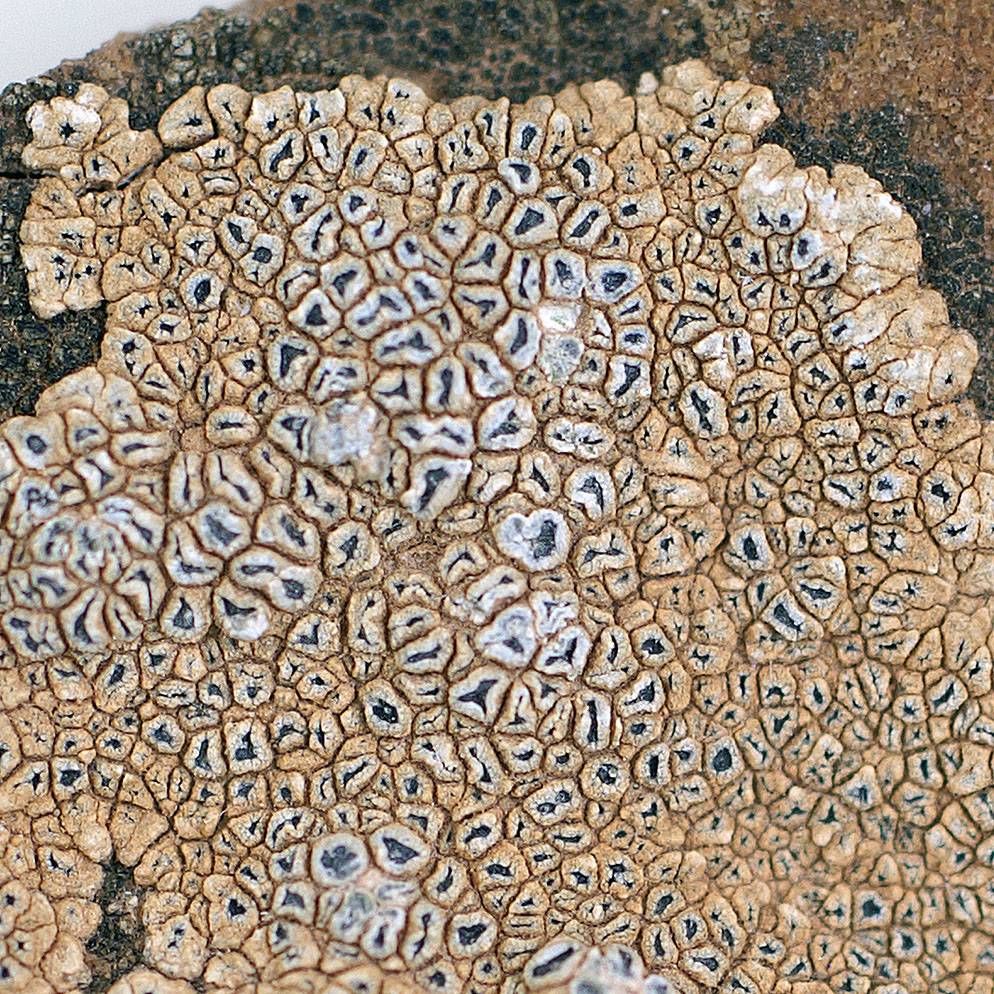
Consortium of Lichen Herbaria
- building a Global Consortium of Bryophytes and Lichens as keystones of cryptobiotic communities -
- Home
- Search
- Images
- Species Checklists
- US States: O-Z >
- US National Parks
- Central America
- South America
- US National Parks
- Southern Subpolar Region
|
Family: Megasporaceae |
Nash, T.H., Ryan, B.D., Gries, C., Bungartz, F., (eds.) 2007. Lichen Flora of the Greater Sonoran Desert Region. Vol 3. Life habit: lichenized Thallus: usually crustose, areolate to rimose; areoles: contiguous to dispersed, sometimes radiately arranged, margin indistinct to distinct, sometimes zonated; some species with radiating marginal lobes, others fruticose (growing loose on soil), or (in some Eurasian species) umbilicate, foliose, or forming globular masses areoles: angular, round or occasionally irregular, slightly concave to flat or ±convex to verrucose prothallus: often indistinct, sometimes ±well developed, fimbriate or forming a zone or a thin film at the margin, mostly dark olive or brown-black to black surface: white to gray, brown or brown-black, often with a bluish or greenish tinge, sometimes ochre or olive, rarely ±orange; dull to ±shiny; isidia or soredia sometimes present; cephalodia absent; pseudocyphellae present in a few species upper cortex: paraplectenchymatous; inner part rarely plectenchymatous (Aspicilia hispida); cortex usually covered with an epinecral layer or crystals medulla: white, I- photobiont: Trebouxia or other chlorococcoid genera; cells ±globose Ascomata: apothecial, aspicilioid, one to several per areole, rarely confluent, usually immersed in thallus, occasionally becoming emergent or ±sessile and appearing lecanorine, round to angular, sometimes elongated or irregular disc: flat to concave, rarely convex, black to brown-black or blue-black, sometimes white-pruinose thalline margin: formed by the margin of the areole, flat and indistinct to ±elevated, sometimes prominent; concolorous with thallus, or sometimes darker, or in some species with a white rim in inner part or entirely white exciple (proper excipulum): often thin but rather distinct in many species, sometimes visible from above as a dark ring or wall around the disc, sometimes almost lacking; excipular hyphae: usually broadening fan-wise in upper part; cells: in uppermost part rounded and brown to olive-brown; usually 20-70 µm wide in uppermost part, I- or I+ partly to entirely blue epihymenium: green to olive, olive-brown or brown, rarely blue-green, N+ green to blue-green ("Aspicilia-green"), K ±brown hymenium: hyaline, rather variable in height in several species, usually more than 90 µm tall, usually I+ blue, persistent or ±rapidly turning yellow-green, yellow-brown or copper-red paraphyses: moniliform, with (3-)4-7(-9) uppermost cells ±globose (3-6 µm in diam.), to submoniliform with 1-2(-3) uppermost cells ±globose to subglobose, or broadly ellipsoid; rarely almost non-moniliform with plainly septate paraphyses without globose apical cells; paraphyses often rather variable even in the same apothecium (best examined in K); in lower part narrow, (1-)1.5-2(-2.5) µm wide, simple to ±branched and ±anastomosing subhymenium: hyaline, usually I+ blue or turning yellow-green to copper-red, sometimes indistinct hypothecium: pale, usually I+ blue or blue-green to yellow-green, sometimes indistinct asci: clavate, Aspicilia-type, wall and apical dome I-, outer coat I+ blue, 2-8-spored ascospores: hyaline, simple, globose to ellipsoid, I-, usually 15-25 µm long Conidiomata: pycnidial, immersed, single or sometimes aggregated; wall: colorless but in upper part brown or sometimes olive to green; ostiole: dark, punctiform to elongated; conidiogenous cells: sessile or on short conidiophores conidia: acrogenous, hyaline, simple, bacilliform to filiform, straight or curved, in some species quite variable in length Spot tests: cortex and medulla I-, K- or K+ yellow or red, P- or P+ orange, C- Secondary metabolites: aspicilin, connorstictic acid, hyposalazinic acid, hypostictic acid, norstictic acid, stictic acid, substictic acid, or no substances habitat: in exposed to shaded situations, sometimes moist habitats, or even ±submerged in water Geography: bipolar, mainly in arid, temperate or polar climates Substrate: mainly on acidic rocks, sometimes calciferous or calcareous rocks, rarely on soil, bark or wood. Notes: The name Aspicilia derives from Greek and means "shield concave", which refers to the apothecia. The genus is distinguished from Lecanora by its I- ascal apical dome, and by its often moniliform paraphyses. Megaspora differs by its very large (over 30 um long), thick-walled ascospores and by growing on mosses or bark or wood; while Lobothallia differs by its lobate thallus and having a brown, N- or N+ slightly green epihymenium (without "Aspicilia-green"). Hymenelia and Ionaspis are distinguished by their thin, non-corticate or weakly corticate thalli and usually pale-colored apothecial discs. Bellemerea differs by having Porpidia-type asci and I+ blue medulla. Pertusaria differs by its larger, often thick-walled ascospores, and thinner, non-moniliform paraphyses. Previous reports of Aspicilia calcarea (L.) Mudd, A. gibbosa (Ach.) Körb. And A. laevata (Ach.) Arnold were based on misidentifications. Furthermore, Aspicilia quartzitica W.A. Weber is a synonym of Schaereria fuscocinerea (Nyl.) Clauzade & Cl. Roux. Lecanora iowensis Fink ex J. Hedrick (type examined!) and Lecanora peltastictoides Hasse (Knudsen and Lendemer 2006c) both belong to Lecanora (Vol. II). Aspicilia albomarginata de Lesd. And A. cinereoglauca de Lesd. Are Mexican species not found in the Sonoran area (types seen!; see the notes on A. americana). The types of the Mexican species Aspicilia mexicana de Lesd., A. mixcoacensis de Lesd., A. salazarensis de Lesd., and A. testaceorubra de Lesd. Have not been possible to locate, and they may have been lost when Bouly de Lesdain's herbarium was destroyed at Dunkirk. DNA (ITS) has been analyzed for several of the species treated here. Short notes of these results are given at each respective species, but more detailed data will be published later. Apothecia: aspicilioid, usually present, rather common, (0.1-)0.3-1(-2) mm in diam., 1-2(-5) per areole, round to angular, sometimes elongated or irregular exciple: (20-)30-70(-100) µm wide, I- or partly I+ blue medially, rarely fully I+ blue; uppermost cells brown to olive-brown, ±globose, (4-)5-6(-8) µm in diam. subhymenium and hypothecium: pale, I+ persistently blue, together (20-)30-60(-70) µm thick soralia: yellow-white, 1-2 per areole or sometimes covering the whole areole surface; soredia 20-40(-60) µm in diam.; |
Powered by Symbiota









